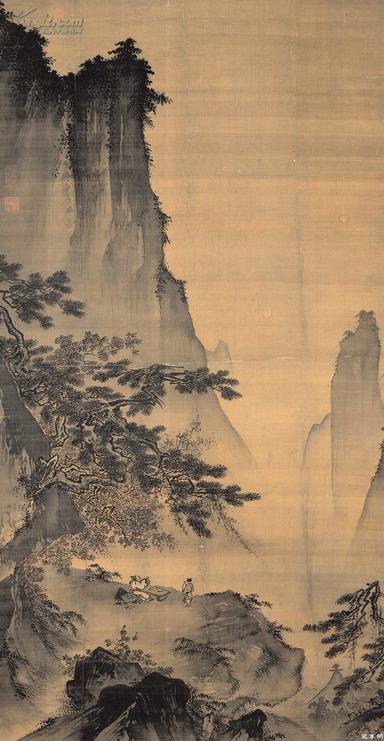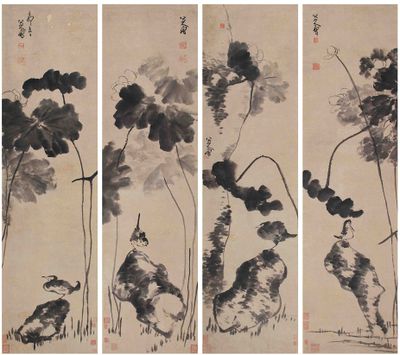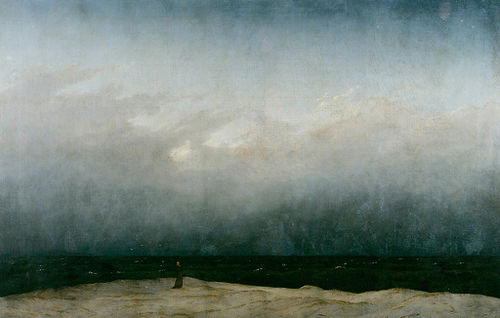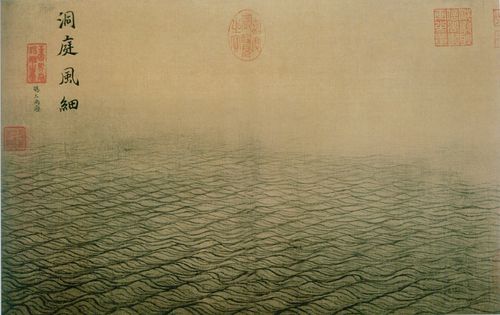User:Chen Junyu/Graduation Project Seminar/ project proposal/3rd
what is my thesis?( Outline )
over the past years I have been trying to clarify my work and find the topic in my work.
1)What is the process of drawing and what is drawing that I think it is meaningful for me.
2) Where is my motivation and inspiration from
3) How can I improve the process of drawing physically and conceptually
Introduction
The earliest scene I can remember till now about drawing is when I was at the age of four or five. There was a national children drawing competition on during that time, so the teacher asked me to participate. The way she guided me was, she made a picture first, a pink pig jumped into deep sea, then she displayed the image on the wall and asked me to draw one as what she did. Then I got a honorable mention and a hard cover book included all prized works by sending 50rmb to the sponsor.
This story has confused me for a long term, it keeps recalling questions as " What is drawing? What does a valued drawing should be? and Why do I need to draw if the scene is already there? ".
This thesis is looking for answers, of course there is not the "correct only one", there should be countless aspects to think about it. However, by going through these questions, I try to clarify my thoughts about drawing and summarize them for a full stop of the story.
Chapter I. The Process
When I am doing pencil sketches, the shadow lines attracted me deeply. Imagine the shadow lines in Ingres sketches, those lines sometimes constitute the grey area, or hided in the drape of clothes or skin, and grows from the drape becoming the edge between brightness and darkness. If we look at those lines carefully, we can see them start with thickness and end up with thinness. The contrast of the thickness and thinness needs to be dealed with carefully, it impacts the texture of work essentially. Each line, point, is the basic and important element to constitute the final work. When we starts transferring the scene -- either in our eyes or in our mind-- to paper, each movement we make for a line or a point, is becoming an independent "work" itself which is depicting a certain part of the reality.
The movement of making lines onto paper, is not a single-track activity, it is interactive. The roughness of paper, sound generated by the friction between paper and pen point, and the continuing change done by the lines which reflects to whole drawing , somehow triggers me to make the next step and influence us on decision making. And this "interactive movement" has an even stronger expression with ink painting. The feature of ink painting is, the skilled usage to material and tools is the fundamental standard to judge a work or a painter. I am not saying the material and tools for ink painting has more difficulties to be expertly mastered, it is fundamental because the way how to control it and the connections between each controlling stages : 1) The material is "soft". Even rice paper which has the best quality can be stored for thousands years, when it encounters with water, it suddenly becomes fragile. And "being fragile" is a necessary step to achieve a work. This characteristic shows most in landscape painting, which is particular strict to the shades and moisture of the ink. Brush is soft. For the very traditional way to make ink painting, teachers usually emphasis on the usage of "Zhongfeng" which means the central hair of the brush should always stay in the middle of the line while drawing. Surely this rule has been ignored for many ink painters who activated since last century, and I don't think to stick on a certain way to paint is a good thing to keep this traditional art growing, however, the concept of "Zhongfeng" does have a deeper meaning. The action of "holding a brush vertically " and "keep the central hair in the middle of line" is a meaningful and effective way to train the painter physically and mentally. It asks for two things: the fully control of hand, wrist, arms, shoulder and back -- stable of the body; and a clear mind without distraction. 2) The process of Chinese ink painting is uncontrollable. Ink has liquidity, and differ with watercolor, the paper ink painting uses has less resistance for it spreading. For example, if we use a fully watering brush draw onto a watercolor paper, almost without time difference, we can see a clear edge of the color without obvious spreading, oppositely, if we use rice paper and brush with same moisture, the ink will spread for a bit while until it half drys. The edge of the ink is unpredictable. And it is exactly part of its charm. Of course every material has its own “free” which painter cannot 100% control with, for ink painting, this “free” is more like the main selection criteria for material.
And that, also reflects the idea of “have-no-activity” in Taoism -- the material always presents their “reply” to paiters’ action, painters should be aware of what is natural effort onto the painting and what is not to keep the dialogue with painting continuing.
While drawing or painting, the information is not unidirectional. Each stroke added to the canvas or paper, will change the aspect of the work, painter analyses the new information and decides what and where to draw next stroke based on it. Drawing or painting is an “event”, for me, because painter keeps communicating with the work, and it is the most charming part of drawing. The information we get keeps updated, maybe we have an idea or sketch about how the work should looks like, but during the procedure of making, the conversation between work and us can always trigger the inspiration.
Barry Le Va's On Center, On Edge Shatter Scatter (1968)
Beyond the information transferation between painter and work, also, each action has certain impact to the older ones. Here is an example of Barry Le Va’s <Shatter scatter>. He places a sheet of glass on the floor, and brokes it by a hammer, then put another sheet of glass on the old,broken one. He repeats the actions for mutiple times. As I see this work is very much like the process of drawing: the result is unpredictable, the artist(painter) only can control part of his work--the shape of scatter, the quantity and the size of the fragments, are all uncontrollable. And every layer which lays upon the older ones, has effected and been effected to the older ones. Drawing is similar in this way -- the painter can do his/her best to control the paint, the brush, the canvas by training, but he/she can never grasp the whole proceeding. Different layers of paint, ink or pigment is always influencing each other -- mix or conflict. There are always some emergent factors happen in the between, it can either be the increasing heart beating, the noise from the outside, or the unpredictable shaking triggered by a passing truck. ( Here "digital" drawing is beyond the scope of the discussion.) Barry Le Va called this work as "isolated isolated contained art", there is on pristine glass tops the others, this act is the relative mounting, to "encases the raw energy of the work's creation"(from the description of Barry Le Va - Shatter scatter by MOCA).
In the small book about zen < Zen in the art of archery>, the author describs so detailly of the procedure he has been through during the study of zen. The different stages he went through reminds me the similar feeling which has flicked in my mind during the process of drawing. To sit quietly, slow the breathing, usually is my first step to immerse myself to the process. It is difficult. Distractions keep coming. The distraction comes from the outside environment and my own mind. From outside is easy to understand however to control the destractions from inside requires discipline. We can block noise, set proper light for drawing, but if the “noises” is coming from inside, how can we block them? Certain proper training does help, my way is before starting a new drawing, make a lot of horizontal lines until my breath becomes steady and slow. However, this “starting actions” is not something done once and for ever, the noise from mind just keeps producing by all kinds of distracted thoughts. This is the ambition of the painter. And no one can do a better judgement than the painter herself if she is totally quiet in mind when she is drawing.
“ When I am in my painting, I'm not aware of what I'm doing. It is only after a sort of 'get acquainted' period that I see what I have been about. ” — Jackson Pollock
This description of Jackson Pollock’s experience of painting, I think it precisely depicts how a “quiet” or “empty” mind should looks like. The actions he took into his painting is not forced, they are generated spontaneously without conscious thinking. It is an ideal or natural condition for drawing or painting.
Chapter II Ancient and Modern
Here is a story about the great Chinese painter Zhang Sengyou (Chinese: 张僧繇)Originally written by Zhang Yanyuan from Tang Dynasty:
Zhang one day decided to paint a dragon on the wall of his house. He guided his brush with full confidence, and after a while the dragon was finished except for its eyes. Suddenly the master's courage failed him. He simply did not dare to paint those eyes. When, many months later, he at last felt brave enough, he groped for his brush and with swift strokes dashed in eye and pupil. Within an instant the dragon broke into cloud roaring and flew away, leaving a trace of fire and smoke.
Here is explanation from a western scholar : “In the Asiatic world, belief in the supernatural power of the artist remained alive over greatly prolonged period. And there was no absolute division between magic, religion and philosophy in the east, especially in China. Taoism, as the primitive Chinese philosophy, effects the developing of Chinese painting on a fundamental base. It influences the establishment of the material system and the construction of the painting principles.” Maybe that can explain why ancient Chinese choose brush, ink and rice paper as the material and tool. (Fritz Van Briessen, < The Way of the Brush>, 2003, page 26 )
The power of the combination of magic, reliogion and philosophy probably is barely to find in current China, but I think the respect to nature power, or, as my understanding, the respect to nature has been spread by different traditional arts
(pic 1, Facing the Moon, Ma Yuan)
This “belif in the supernatural power” somehow attracts and impacts me, not because the faith in supernatural, but the harmony between human and nature which is conveyed from those ancient paintings which I know deeply that it is impossible to be replayed today because of the cultural and geographical reason.
The “hamony” is no way to replay anymore, but I still can trace it by these old masterpieces. There are two things of Chinese philosophy has influenced Chinese art on a fundamental level, one is the aspiration to "nature"( the ideal nature in Taoism also physically beautiful nature in the ancient time), and the usage of metaphor. There is a poetry describes the aspiration to nature by Tao Yuanming (365–427) from Eastern Jin Dynasty:
I built my hut in a zone of human habitation,
Yet near me there sounds no noise of hourse or coach,
Would you know how that is possible?
A heart that is distant creates a wilderness round it.
I pluck chrysanthemums under the eastern hedge,
Then gaze long at the distant summer hills.
The mountain air is fresh at the dusk of day;
The flying birds two by two return.
In these things there lies a deep meaning;
Yet when we would express it, words suddenly fail us.
(Translated by Arthur Waley)
" Here we have Taoism at its best." ( Fung, 1948)Taoism is one of the main philosophical genres from ancient China. "In these things there lies a deep meaning; Yet when we would express it, words suddenly fail us." It does express the most obvious differences between Chinese and Western philosophy. Thus the usage of metaphor in Taoism is quite common. Metaphor is so vague and unspoken. The widely appearance of metaphor in literature works of philosophy makes it so difficult for people to understand the whole purpose, somehow it asks the reader to train their ability to think and feel, either for daily routine or the real truth of life and universe. I don't believe this "unspoken" feature is an expression of mysticism of Chinese philosophy, it is more like what Zen says, human language is not a proper tool to express the deep truth , and it can only be experienced by the deep heart. However, as an artistic language, painting (and other artistic forms ) is possible to express this “deep meaning” in the poem.
Thus when we appreciate Chinese paintings, there usually is partly empty space left, whether landscape painting or still life. For example, Ma Yuan, one of my favorite painter who activated in 12th century, is famous for his special composition style “one corner” , in which he only places the subjects of the painting to one corner or one side, and leave the other parts empty.
(pic 2 , Lotus, Rocks and Water Fowls, Badashanren )
Another example is from great painter Badashanren, who lived in 17th century, is famous by his minimalist image and technique with strong personal style to depict still life. He rarely follows the practical principle of Chinese ink painting such as certain expression style of branches or leaves, but the “tao” which circulating in his paintings is similar with in Ma Yuan’s works.
This idea of “tao” is coming from Lao Ztu and Zhuang Ztu, they believe the deepest understanding about life and the universe we live in is to forget about the distinction between things, even forget about the distinctions of things appear in one’s life. And this lost of distinction is not because of ignorant, is because of nescience after fully understanding. Everything in the world combines together as a vague entirety, and Tao goes through them as “none”. Perhaps the empty painters left on their works, is just the shapless depicting “tao” or the space left specially for tao going through. The way painters use the empty space, is exactly the way how he or she understands “tao”.
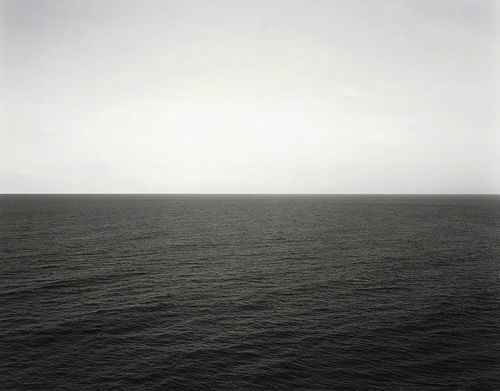
Hiroshi Sugimoto - Seascape: Baltic Sea, near Rügen, 1996
Caspar David Friedrich - The Monk By The Sea, 1808
Ma Yuan - A Series Paintings of Water, around 1200
Here are three images depict the “Sea”, done by artists from different ages. They all depict the view of sea, from different aspects, using different construction and mediums. However, since they chose the same topic, we could trace these images to speculate their understanding and motivation for depicting the nature. The newest work is Hiroshi Sugimoto’s <Seascape>. This one has the strongest contrast on black and white in the series. The construction is perfectly balanced to transfer very much silent atmosphere. Somehow It looks the photographer cannot control the subject, the danger is obvious. Sugimoto tried to present the connection between the “uncontrolablle sea” and him precisely. The second one was painted by Caspar Friedrich. He chooses a monk as the main element in the image, which has the association about unselfishness, clean or solitary. He seems place himself as a remote viewer, and discreetly keeps the distance to the scene, he is not involved. The third one is made by Ma Yuan. His painting is much more released, the seascape, the fog over the sea, the waves changing... the world he depict is a whole, either the seascape or the painter himself.
I am fasinated by all of three images, for the richness presented in the paintings or photo and the diversity of the attitudes these artists show to us. On the other hand, these images are telling three stories about the connection between human and nature in ancient, recent and modern time. The differences of culture and painters’ characteristic can not be ignored, however what I feel interesting is the huge jump from “a harmony whole” to the “cold, vast sublime” through time.
There is no doubt that we already live in a world totally different from the world that ancient Chinese live with. The landscape has changed in a big scale, hermits who inherit lineal Taoism may only sparsely live in the Zhongnan Moutains. The regret I feel to the passed world probably is because of my idealistic imagination. Just as Kurt Hentschlager’s question to the definition of nature “ Is the nature what existed before we became a conscious species? Is nature what surrounds us at any given time? Are cities, farms, industrial areas not just part of today’s nature? We deem something unnatural or artificial when it’s newly introduced. Once mass adopted, it quickly becomes a ‘natural’ part of our lives.” I have been confused by the same questions, we live in cities which basically isolated from the “nature” in our impression, so how can we depict a pure nature if we never really get on with?
But If we use the definition of nature in Taoism to define the world, the concept can be clearer. Most of the world seems belongs to the “unnatural” camp. Because the world is definitely a combination of complexity, not simplicity. Since there is no way to execute a reversion for the world, discussion about the growing amounts of “unnatural” seems have little meaning. This old philosophy (also other genres of Chinese philosophy) has nothing to do with the physical world on the fundamental level, the outcome of industrial and technology revolution is becoming or already is part of our “nature”. The original nature, just like the darkness at night, is already disappeared before we notice. What can survive in the modern world is, the natural mind which everyone has the oppotunity to own. That is also what I want to achieve through drawing. "Natural mind" means following one's Te with no arbitrary effort. Te means live with simplicity. In doing this one should take simplicity as the guiding principle of life.”(A Short History of Chinese Philosophy,1948). It seems very vagure and abstruse. Quoted from Zhuang Ztu: “A free development of our natures may lead us to a relative kind of happiness; absolute happiness is achieved through higher understanding of the nature of things. … we should have a full and free exercise of our natural ability.” In connection with this idea of free development, Chuang Tzu makes a contrasl between what is of nature and what is of man. ‘What is of nature,’ he says, ‘is internal. What is of man is external. ...That oxen and horses should have four feet is what is of nature. That a halter should be put on a horse's head, or a string through an ox's nose, is what is of man.’” That may indicate why those occasionally appeared human characters in Ma Yuan’s painting always represent immortal temperment.
As my understanding, it means live with simplicity, with natural consciousness and without external drive and disttraction. It is a life long process to achieve the goal, and one thing should be done before the journey is to be honest to self. It is the only way to reach the goal -- have natural, simple mind while drawing. It is the ideal and achievable way to draw as natually as I can. As Philip Rawson says, appreciating a drawing is a procedure of “spiritual scanning” done by viewer to the painter. And through this, I can get to make deeper connection with those ancient masters by “spiritual scanning”.
Chapter III
Last year I have made a work < How to draw a perfect circle >. This work is consisted by a video depicting the process of drawing circles and the physical drawings. The video starts with 300 animated circles, showing one by one continuely, then there are three screens presented the repeat of the movement of drawing circles. Beside the video, 300 sheets of circle drawings are placed in a transparent box. This work is not literally explaning "how to draw a perfect circle", it trys to express the endless way to the stage of perfect which we all know it is unreacherable. But sometimes the “unreachable” can become the motivation to make us get as much close as we can to being “perfect”.
The story I tell at the beginning of the thesis, has influenced me on a fundamental level. Why do we need to copy others’ work or even the scene already exist there? I instinctively refuse to draw or paint any topics that I have seen before. Since the impression of these images left in my mind, the way how I design a new work is not by choosing elements I am interseted in and compose them, instead, I start a work from “avoid all the similar scenes in my mind”. Even literally I do understand the importance of “copying”, through the action of copying we can really go through the journey which the original author has gone through and benefit from that, I still resist the action of “copying” spiritually. I have lost the inspiration to create my language. At the beginning of making circles or minimal lines I didn’t think about it is physically copying the movement, what I get is the release by empty my mind without the thought of “avoid similar scenes”. Through the minimal lines, I can generate something purely personal and individual, which is the display of my spiritual and physical state. And that is a continuing changing and never repeated process. It is the natural way to draw for me.
Roughly look at the lines, they are similar. There is an interseting tradition in Chinese ink painting, painters usually do not create
When I look back this work now, I can see my motivation and inspiration more clearly. That is the process I have been through. The original intention to drawing or painting is the uncarved stone, but through time, for sure, the intention and motivation will be impacted by the outside, either good or bad. What I try to achieve is, by going through strugglling, confusion, hesitation and slackness, chip away the redundant part which added by outside from the stone to finally get back to the condition of “uncarved stone” as origin. What this motivation reflects on practicing, just as what Feng Youlan has summerised: “According to the theory of "having-no-activity, a man should restrict his activities to what is necessary and what is natural. " Necessary means necessary to the achievement of a certain purpose, and never over-doing. "Natural" means following one's Te with no arbitrary effort. In doing this one should take simplicity as the guiding principle of life.”(A Short History of Chinese Philosophy,1948).

